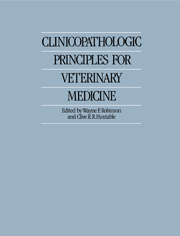Book contents
- Frontmatter
- Contents
- Contributors
- Preface
- Acknowledgements
- 1 The relationship between pathology and medicine
- 2 The immune system
- 3 The hematopoietic system
- 4 Acid–base balance
- 5 The respiratory system
- 6 The cardiovascular system
- 7 The alimentary tract
- 8 The liver and exocrine pancreas
- 9 The urinary system
- 10 The endocrine glands
- 11 The skin
- 12 The skeletal system
- 13 The nervous system
- 14 Muscle
- 15 Metabolic disease
- 16 The reproductive system
- Index
1 - The relationship between pathology and medicine
Published online by Cambridge University Press: 19 January 2010
- Frontmatter
- Contents
- Contributors
- Preface
- Acknowledgements
- 1 The relationship between pathology and medicine
- 2 The immune system
- 3 The hematopoietic system
- 4 Acid–base balance
- 5 The respiratory system
- 6 The cardiovascular system
- 7 The alimentary tract
- 8 The liver and exocrine pancreas
- 9 The urinary system
- 10 The endocrine glands
- 11 The skin
- 12 The skeletal system
- 13 The nervous system
- 14 Muscle
- 15 Metabolic disease
- 16 The reproductive system
- Index
Summary
The aim of this book is to assist the fledgling clinician to acquire that ‘total view’ of disease so essential for the competent diagnostician. The typical veterinary medical student first encounters disease at the level of cells and tissues, amongst microscopes and cadavers and then proceeds rather abruptly to a very different world of lame horses, vomiting dogs, panting cats, scouring calves, stethoscopes, blood counts, electrocardiographs and anxious owners. In this switch from the fundamental to the business end of disease, the link between the two is often obscured. It is easy to forget that all clinical disease is the result of malfunction (hypofunction or hyperfunction) within one or several organ systems, and that such malfunction springs from some pathologic process within living tissues.
Although some disease processes are purely functional, in most instances the pathologic events involve structural alteration of the affected organ, which may or may not be reversible or repairable. At least one of the basic reactions of general pathology, such as necrosis, inflammation, neoplasia, atrophy or dysplasia, will be present.
The expert clinician, having recognized functional failure in a particular organ as the cause of a clinical problem, is easily able to conjure up a mental image of the likely underlying lesion and take effective steps to characterize it. This characterization of the underlying disease opens the way for establishing the etiology and appropriate prognosis and management. By contrast, the novice tends to stop short at the stage of identifying organ malfunction, neglecting the important step of characterizing and comprehending the nature of the tissue disease.
- Type
- Chapter
- Information
- Publisher: Cambridge University PressPrint publication year: 1988



